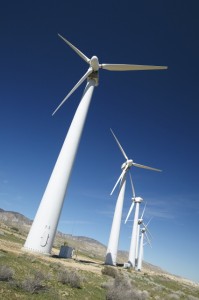 Wind energy is derived from – you guessed it – the wind. Being a prairie province, Manitoba has lots of wind.
Wind energy is derived from – you guessed it – the wind. Being a prairie province, Manitoba has lots of wind.
In a modern horizontal-axis wind turbine (HAWT), the wind rotates a huge three-bladed fan. This fan has a generator in its hub that creates the electricity.
On this page, we deal with these issues related to wind energy in Manitoba:
Click a link in the list above to jump to that topic on this page.
Advantages
Wind power is very clean. After installation, it generates virtually no greenhouse gases or other pollution.
Wind turbines can be located on a variety of different terrains, including on farm land, which allows for existing infrastructure to continue operating in the same capacity. For example, wind turbines are a very common sight on farms in Southern Ontario. Landowners can continue to farm, while also benefiting financially from the electricity generation.
Difficulties
The power is only provided when the wind blows, not when demand is high.
There were some problems in earlier models with noise and with blades breaking off and being thrown long distances (tip speeds can reach 225 KPH (1)). However, modern designs are very quiet and safe.
There is a mixed opinion about the sight of wind farms. Some people consider them to be visual pollution, cluttering the landscape; others see them as simple, elegant, and beautiful.
Sometimes birds and bats are struck by the large, fast-moving blades. This is a particular concern during bad weather and if wind farms are in known migratory flight paths. (2) However, the overall risk to birds from wind turbines pales compared to the risk from cars, trucks, and picture windows. (3)
Ice will sometimes form on the blades and be thrown a considerable distance by the speed of the rotors. (4) This is one of the reasons turbines are usually placed away from other buildings and people.
Current situation
Manitoba has had a 99 megawatt (MW) wind farm in operation near St. Leon since 2005. The wind farm consists of 63 turbines, each 80 metres high, with three 41-metre blades. At the tip of its highest blade, each turbine reaches about 34 storeys, into the air.(5)
The St. Joseph Wind Farm is Manitoba’s second wind energy power plant. It started operation in 2011 with 60 turbines with a total rating of 138 megawatts.(6)
Future possibilities
As a Prairie province with lots of farms and open spaces, Manitoba has many areas available for installing wind turbines. The Province of Manitoba, along with Manitoba Hydro, hopes to add 300 MW of wind power to the province’s energy grid – enough power for 100,000 homes. That could mean up to 160 more windmills. (The number could be smaller due to new and evolving wind turbine technology.) (7)
SEE ALSO: Wind power in the solutions > Home construction section of this website.




